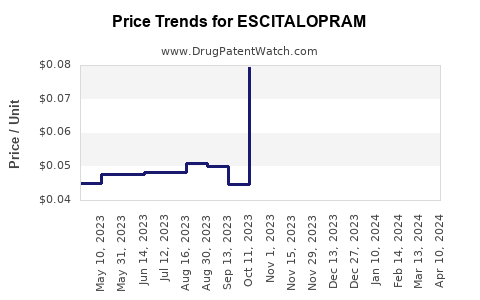Last updated: July 27, 2025
Introduction
Escitalopram, marketed under brand names such as Lexapro and Cipralex, is a selective serotonin reuptake inhibitor (SSRI) widely prescribed for depression and generalized anxiety disorder. Its proven efficacy, favorable safety profile, and broad application have cemented its status as a key players in the global antidepressant market. Analyzing its current market state and projecting future price trends offer critical insights for stakeholders from pharmaceutical firms to healthcare providers and investors.
Market Landscape
Global Pharmaceutical Market for Escitalopram
The global antidepressant market was valued at approximately USD 17.8 billion in 2022 and is projected to grow at a CAGR of 2.9% through 2028, driven by increasing mental health awareness and higher diagnosis rates [1]. Escitalopram holds a significant market share within the SSRI segment, estimated at approximately 35-40% of the antidepressant market as of 2022, owing to its high tolerability and rapid onset of action.
Key Pharmaceutical Players
Major pharmaceutical companies manufacturing escitalopram include:
- Forest Laboratories (AbbVie): Original manufacturer for Lexapro.
- Teva Pharmaceuticals: Generic developer and marketer.
- Eli Lilly & Co.: Licensed the drug outside the U.S.
- HPV Genesis and other generics producers: Increasing penetration as patent exclusivity expires.
Patent Status and Generic Competition
The original patent for Lexapro expired in 2012 in the U.S., prompting a wave of generic launches. Currently, a substantial portion of the market comprises generic formulations, which significantly depress price levels. However, brand-name versions retain some premium pricing in specific markets, supported by physician and patient loyalty.
Regulatory and Pricing Dynamics
Regulatory agencies like the U.S. Food and Drug Administration (FDA) and the European Medicines Agency (EMA) influence market dynamics through approval processes, patent protections, and biosimilar pathways. Mandatory pricing negotiations, especially in countries with government-controlled healthcare systems, also impact retail prices.
Market Drivers and Challenges
Drivers
- Growing Mental Health Burden: An increasing prevalence of depression and anxiety disorders globally.
- Expanding Indications: Off-label use and expanding indications, including obsessive-compulsive disorder.
- Healthcare Access: Improved screening and mental health services, boosting prescription volume.
- Patent Expiries and Generics: Introduction of generics reduces costs, expanding the patient base.
Challenges
- Price Erosion: Generics and biosimilars cause significant price reductions.
- Market Saturation: High maturity in developed markets limits growth.
- Generic Competition: Multiple generic manufacturers entering markets reduces pricing power.
- Regulatory Risks: Potential for new guidelines affecting drug approval or reimbursement.
Price Trends and Projections (2023-2030)
Current Price Landscape
In the U.S., the average retail price for branded escitalopram (Lexapro) in 2023 ranges from USD 300 to 400 per month (per patient, retail), owing to insurance settlements and pharmacy benefit managers’ negotiations. Generic formulations, however, are priced significantly lower, often below USD 50 per month.
Future Price Trajectory
Based on historical data and industry trends, the following projections are outlined:
- 2023-2025: Marginal decline in branded drug prices due to ongoing generic competition, with a stabilization at around USD 250-350 per month.
- 2026-2028: Continued erosion of brand premium; generic prices expected to decline further, stabilizing around USD 20-50.
- 2029-2030: Price levels for generics could reach USD 10-30, driven by increased market penetration, new formulations, and biosimilar entrants.
Influence of Market Dynamics
- Biosimilar Entry: Although less common for small molecules like escitalopram, biosimilars for similar drugs could influence prices.
- Pricing Reforms: Governments in Europe and Asia implementing more aggressive pricing controls could suppress prices further.
- Emerging Markets: Rapid penetration in Asia, Africa, and Latin America could lead to volume-driven revenue despite lower prices.
Strategic Implications
- Brand vs. Generic Dynamics: Companies focusing on branded formulations should anticipate continued price erosion; however, diversification into niche indications or fixed-dose combinations may mitigate pressure.
- Market Expansion: Emerging markets offer opportunities for volume growth despite lower per-unit prices.
- Innovation and Line Extensions: Developing novel formulations or combination therapies could command premium pricing and extend lifecycle.
Conclusion
The global escitalopram market is characterized by mature dynamics with significant generic penetration, leading to downward price pressures. While the overall market is expected to continue its modest growth driven by increasing diagnosis and expanding treatment access, the average price per unit for escitalopram is projected to decline steadily over the coming years. Stakeholders must adapt to these trends through strategic positions in emerging markets, innovation, and optimized pricing strategies.
Key Takeaways
- The global antidepressant market, including escitalopram, is expanding due to rising mental health concerns but faces pricing pressures amid high generic competition.
- Branded escitalopram prices are expected to decline from USD 300-400/month in 2023 to potentially USD 10-30/month by 2030 in generics-dominated markets.
- Market growth will primarily stem from volume increases in emerging economies where affordability and access are improving.
- Patent expiries and biosimilar developments will further depress prices and intensify competition.
- Strategic diversification and innovation are vital for manufacturers aiming to preserve margins and market share.
FAQs
-
What is the primary driver for price reductions in escitalopram?
The key factor is patent expiration leading to widespread generic competition, significantly lowering manufacturing and retail prices.
-
How does regulatory policy influence escitalopram pricing?
Governments and regulatory bodies can impose price caps, reimbursement limitations, and approve biosimilars, all of which pressure market prices downward.
-
What markets offer the most growth potential for escitalopram?
Emerging economies in Asia, Africa, and Latin America are poised for growth due to increasing healthcare infrastructure, diagnosis rates, and affordability.
-
Will new formulations or delivery systems affect escitalopram prices?
Yes, innovative formulations such as extended-release versions or fixed-dose combinations may command higher prices initially, though their impact on overall market prices remains limited in mature markets.
-
How do biosimilars impact the overall market for escitalopram?
While biosimilars specifically target biologics, their emergence in similar drug segments can indirectly influence pricing strategies and competitive dynamics for small-molecule drugs like escitalopram.
References
[1] MarketWatch. "Antidepressants Market Analysis, Size, Share, Trends & Forecasts 2022-2028."
[2] IMS Health Reports. "Global Psychiatry Drug Market Trends 2022."
[3] European Medicines Agency (EMA). "Regulatory Pathways for SSRIs and Biosimilars."

